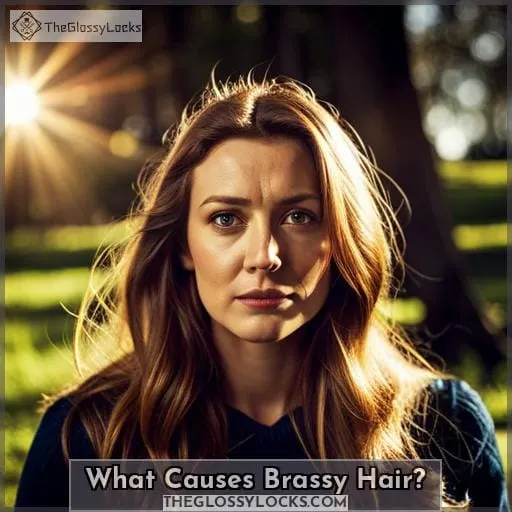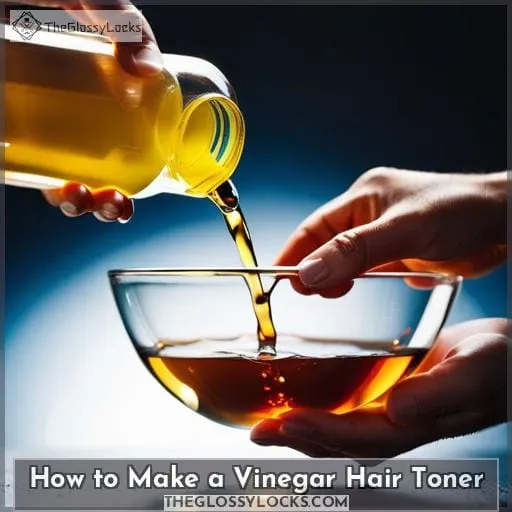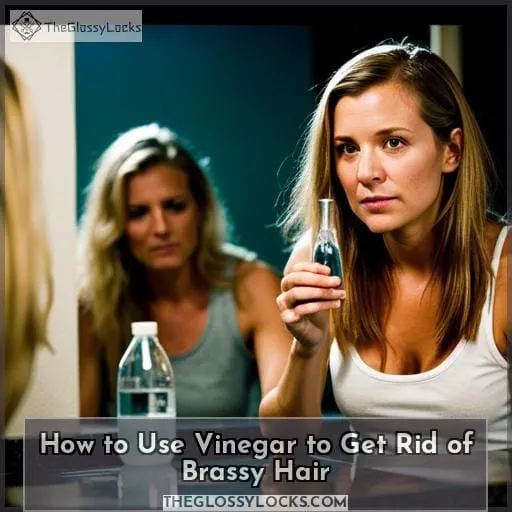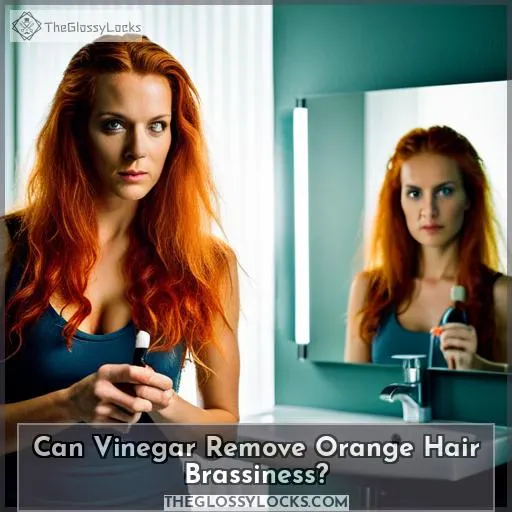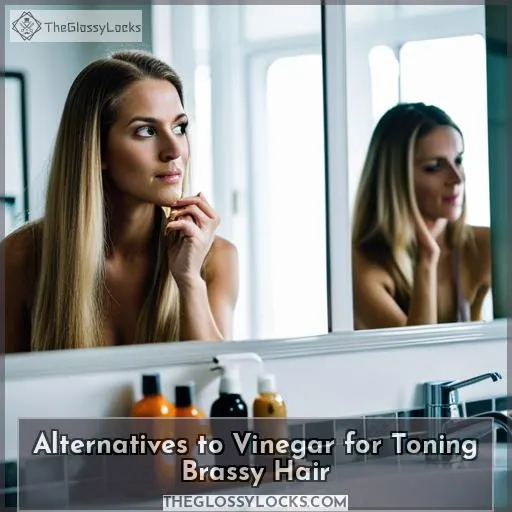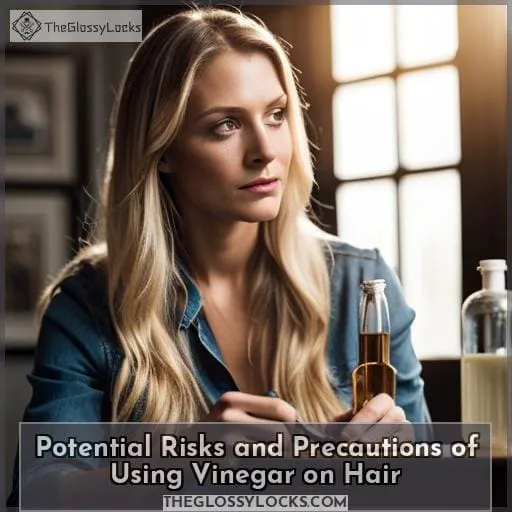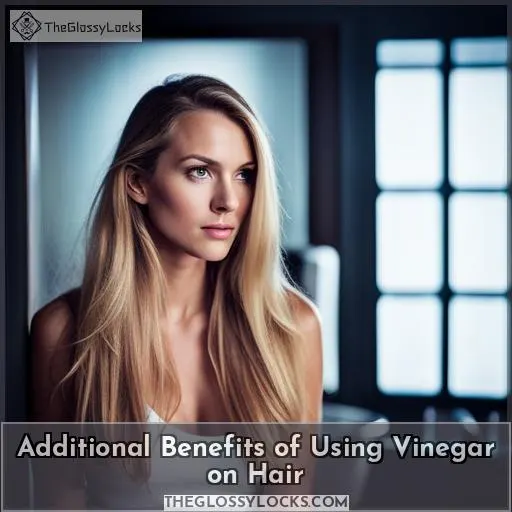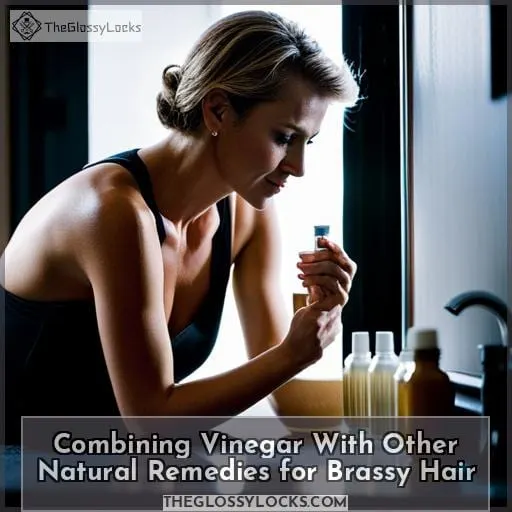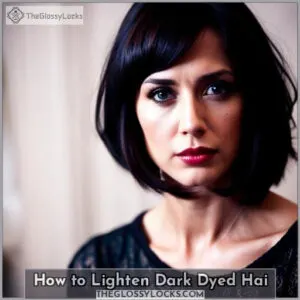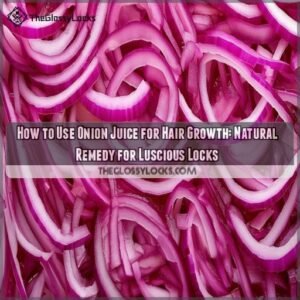This site is supported by our readers. We may earn a commission, at no cost to you, if you purchase through links.
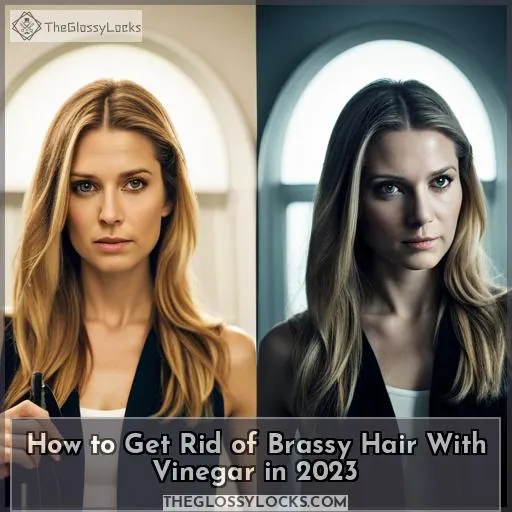 Do you ever feel like your blonde hair has been overtaken by brassy, orange tones? You’re not alone.
Do you ever feel like your blonde hair has been overtaken by brassy, orange tones? You’re not alone.
Vinegar has powerful properties that can help tone down brassiness and restore the vibrancy of your locks in just a few simple steps. In this article, I will share how to get rid of brassy hair with vinegar in 2023 – including which type works best for treating different shades of blonde as well as other natural remedies you can use alongside it for extra toning effects.
Keep reading to learn more about the power behind vinegar so you can start saying goodbye to unpleasant yellowish hues today!
Table Of Contents
- Key Takeaways
- What Causes Brassy Hair?
- Why Vinegar is Effective for Treating Hair Brassiness
- How to Make a Vinegar Hair Toner
- How to Use Vinegar to Get Rid of Brassy Hair
- Can Vinegar Remove Orange Hair Brassiness?
- Alternatives to Vinegar for Toning Brassy Hair
- Potential Risks and Precautions of Using Vinegar on Hair
- Additional Benefits of Using Vinegar on Hair
- Combining Vinegar With Other Natural Remedies for Brassy Hair
- How Long Does It Take to See Results With Vinegar Toning?
- Frequently Asked Questions (FAQs)
- Conclusion
Key Takeaways
- Vinegar, specifically apple cider vinegar or white vinegar, can be used to tone brassiness or orange hues in hair.
- Dilute vinegar with water in a 1:4 ratio and apply after shampooing, leaving it on for 5-10 minutes before rinsing.
- Vinegar helps remove mineral buildup, balances pH levels, and enhances shine.
- It is important to dilute vinegar properly and not leave it on for too long to avoid overdrying or irritation.
What Causes Brassy Hair?
You may be noticing brassiness in your hair due to minerals, chlorine, sun exposure, or a poor dye job. Using vinegar is an effective and inexpensive way to balance the pH of your hair and reduce the brassy tones.
Split ends caused by heat styling or chemical treatments can also contribute to brassiness. Even cold water rinses with hard water can leave behind mineral deposits that make blonde strands appear more yellow than they should.
White vinegar has acetic acid, which helps remove product buildup while balancing out pH levels. So, you get fewer unwanted orange/yellow tones in bleached blonde locks when it’s diluted with warm water (1 part white vinegar: 4 parts warm distilled).
Apple cider vinegar is another great option as its antibacterial properties help keep scalp irritation at bay while conditioning dry tresses from root-to-tip for added shine.
When used consistently every couple of weeks, this natural method will gradually restore blondes back into their former glory without any harsh chemicals involved. Just rinse, then shampoo as usual for best results. But don’t overuse it, otherwise, you risk drying out your strands too much! Lastly, try combining white vinegar with purple food coloring if DIY purple shampoos aren’t doing enough against stubborn yellow hues.
This works especially well on lighter shades like platinum blonde since lemon juice won’t work here because of its acidic nature.
So next time those pesky brassy bits start showing up again, reach for some good old apple cider vinegar instead and watch how quickly things transform before your eyes!
Why Vinegar is Effective for Treating Hair Brassiness
Are you looking for an effective and natural way to get rid of brassy hair? Look no further than vinegar, which has been used as a remedy since ancient times. Not only does it balance the pH levels of your tresses thanks to its acetic acid content, but it also removes any product buildup and can even tone down yellow/orange tones from bleached locks.
PH Balancing Properties
With vinegar’s powerful pH balancing properties, you can quickly restore your blonde locks back to their former glory without harsh chemicals. Equal parts of apple cider vinegar and water can be used as a rinse after shampooing to help balance out the hair’s pH levels while sealing the cuticle for added shine.
Its antimicrobial effects also reduce scalp irritation and dandruff, so it’s great for all hair types! Moreover, ACV helps remove orange tones that are often caused by mineral deposits or chlorine exposure.
With consistent use every 2-4 weeks over time, you’ll notice a difference in how soft and shiny your mane looks compared to before using this natural method – plus no risk of drying out strands with proper dilution techniques!
Removal of Mineral Buildup
By using vinegar to rinse your hair, you can help remove the mineral buildup that causes brassiness. Apple Cider Vinegar (ACV) is particularly effective because of its ability to balance pH levels and correct color without causing damage.
The acetic acid in ACV works on orange tones caused by minerals or chlorine exposure too, making it an ideal choice if lemon juice isn’t enough for stubborn yellow hues. Dilute the vinegar with cool water before applying directly to wet hair after shampooing and leave it on for 5-10 minutes before rinsing off thoroughly.
Not only will you see a noticeable difference in shine, but you’ll also have fewer split ends due to better maintenance of your mane’s natural mineral content!
Toning Effects
Experiment with ACV toner for a deeper, lasting blonde shine and to help reduce orange tones over time. Mix two tablespoons of apple cider vinegar with water and add drops of purple food coloring or lemon juice for extra brightening power.
Acetic acid in the vinegar helps restore natural color as well as removing yellow/orange hues from hair over time. For best results, use consistently every couple of weeks; just don’t leave it on too long or you’ll risk drying out your tresses! Keep up this routine regularly to get that stunningly vibrant look you desire.
How to Make a Vinegar Hair Toner
Ready to get rid of that brassy hair once and for all? Look no further than vinegar! Apple Cider Vinegar (ACV) toner recipes and white vinegar rinses have been used as remedies since ancient times, so why not give this age-old solution a try today? ACV tones blonde locks, removes product buildup, and balances pH levels while the white vinegar rinse is great for removing yellow/orange tones from bleached hair.
Apple Cider Vinegar Toner Recipe
Try an Apple Cider Vinegar Toner to restore your blonde shine and tone down yellow/orange tones from bleached locks naturally.
All you need is two tablespoons of ACV, one cup of water, plus some optional honey or oils if desired.
Leave the toner on for thirty minutes with a shower cap before rinsing off. This will help make sure the acidic nature of apple cider vinegar can penetrate deep within your strands, while taking advantage of its antimicrobial properties too!
You’ll be able to get rid of dandruff or itchy scalp issues as well as controlling low-quality hair dyes that are causing brassy tresses – it’s truly a win-win situation!
For an added boost in color correction, try adding purple food coloring to create DIY purple shampoo.
With regular use every couple of weeks, this natural toner will work wonders for all kinds.
White Vinegar Rinse Recipe
For an even more powerful brassiness solution, pour some white vinegar into your shampoo bottle like liquid gold and wash away any yellow or orange tints with ease!
A white vinegar rinse recipe is a great way to tone down unwanted hues:
- Start by diluting 1/2 cup of the acidic tonic in 1 cup of water.
- Massage it through wet locks for 3-5 minutes after washing.
- Follow up with conditioner and let sit before rinsing completely out.
- Use this natural toner every few weeks to keep hair looking silky smooth!
The acetic acid in white vinegar works wonders on blonde hair as well, removing stubborn yellow or orange tones without chemical treatments that can be damaging over time.
Try adding some food coloring for DIY purple shampoo if desired; just make sure not to leave it on longer than 10 minutes so your strands stay healthy and hydrated afterwards.
How to Use Vinegar to Get Rid of Brassy Hair
If you’re looking for an effective solution to get rid of brassiness, why not try using vinegar? Diluting it with water and applying it after shampooing is a great way to start. Leave the mixture on for 5-10 minutes before rinsing. For best results, use this method every 2-4 weeks consistently.
Dilution and Application Process
To successfully use vinegar to banish brassiness, start by diluting it with water and apply after shampooing. Depending on your hair type, combine equal parts of vinegar and water in a spray bottle for optimal toning effects.
For best results, saturate damp hair with the mixture while paying special attention to your roots. Let it sit for 5-10 minutes before rinsing thoroughly to remove all traces of styling products or natural oils from your scalp area.
Try incorporating white distilled vinegar into your routine if blonde tresses are giving you trouble – its acetic acid content makes it an even more powerful solution for lightening unwanted yellow/orange hues over time!
Duration and Frequency of Use
Use vinegar consistently every few weeks to keep brassiness at bay and maintain your hair’s natural beauty. Taking the right steps in your weekly hair care routine can ensure that you get the best toning effects without any dryness risks.
Start by diluting equal parts of vinegar with water in a spray bottle.
Saturate damp hair with this mixture, focusing on roots.
Leave it on for 5-10 minutes before rinsing thoroughly – no need to use store-bought products!
Incorporating white distilled vinegar into your regimen is also beneficial for blonde tresses as its acetic acid content works wonders against yellow/orange hues over time, all while promoting scalp health and enhancing shine!
If done correctly, you won’t have to worry about future fading due to regular use of this simple yet effective natural remedy – just make sure not to leave it too long or else risk drying out your locks!
Can Vinegar Remove Orange Hair Brassiness?
Yes, vinegar can help you reduce orange or brassy tones in your hair. Whether it’s white vinegar or apple cider vinegar (ACV), this popular home remedy is an easy DIY solution to get rid of orange hair and restore scalp health.
One way to use ACV is by diluting it with water and applying the mixture after shampooing for 5-10 minutes before rinsing. This helps balance pH levels, remove brassiness, seal cuticles, reduce breakage, and add shine! For best results, do this every 2-4 weeks consistently as overuse can cause dryness/irritation.
Alternatively, mixing lemon juice with honey makes for a great mask that can be applied directly onto wet hair for 30 minutes, followed by a rinse – restoring blonde shine without any chemicals!
If these don’t work, then purple/blue shampoos are also worth trying out. They often contain cool pigments that keep the yellow tones at bay while providing nourishment too!
Finally, why not try making your own purple shampoo? Just mix some food coloring into white distilled vinegar – 1/2 cup of each should suffice. Leave it on for 3-5 minutes after washing and follow up with conditioner afterwards to prevent damage from acidity.
Alternatives to Vinegar for Toning Brassy Hair
If you’re looking for alternatives to vinegar for toning brassy hair, purple or blue shampoos and a lemon juice and honey mask are great options. These treatments add nourishment while keeping yellow tones at bay. Plus, they don’t require the same level of commitment as a regular ACV rinse! To make your own purple shampoo, mix white distilled vinegar with food coloring – just 1/2 cup of each should do the trick.
Purple/Blue Shampoos
Try purple/blue shampoos to combat brassy tones in your hair and experience the nourishing benefits of cool pigments while restoring blondeness. These all-natural products are a powerful natural remedy, perfect for keeping orange balance and making sure your hair remains healthy.
- Purple dyeing is an easy way to manage brassiness – no need for vinegar toning!
- These shampoos make it possible for anyone with any shade of blonde or light brown hair to maintain a stunning mane without needing harsh chemicals.
- For those seeking a natural alternative, they can also be used as part of a regular haircare routine instead of using ACV rinses every few weeks.
The result? Soft, shiny locks that look salon-fresh after each use! So if you’re looking to get rid of orange hues quickly and effectively without damaging your strands – give purple/blue shampoo one shot today!
Lemon Juice and Honey Mask
Experience the nourishing effects of lemon juice and honey with this simple mask, perfect for keeping brassiness at bay while restoring brilliant blondeness. The acidic nature of both ingredients helps to rebalance pH levels in your hair, combating orange tones caused by improper dyeing or exposure to too much sun.
Combining these two items creates a toner recipe that is gentle enough for all types of hair yet strong enough to remove brassy hues quickly and effectively. Mix equal parts freshly squeezed lemon juice with honey and apply it directly onto wet strands after shampooing; leave on for 30 minutes before rinsing off thoroughly with water.
Not only will it help restore shine back into dull-looking locks but its acidic properties also smoothen out cuticles, preventing frizziness as well as breakage from occurring down the line! Try this homemade remedy today – you won’t regret it!
Potential Risks and Precautions of Using Vinegar on Hair
Before using vinegar on your hair to reduce brassiness, it’s important to be aware of potential risks and precautions. Vinegar is powerful enough that if used in excess or too frequently, it can have a bleaching effect as well as cause scalp irritation and overdrying due to its acetic acid content.
Additionally, environmental factors like humidity can affect how ACV acts on wet locks, so results may vary depending on the climate you live in.
Lastly, since vinegar strips away essential nutrients from hair strands while toning color pigments, prolonged use could damage your tresses if not diluted correctly with water before application!
However, when done properly with proper safety measures taken into consideration, ACV is still a great choice for removing brassy tones without harsh chemicals.
To prevent any kind of skin sensitivity or other adverse effects, make sure you dilute one part vinegar with two parts water before applying onto clean wet hair. Then, rinse off after 5-10 minutes, allowing time for all necessary benefits but preventing overuse.
With consistent use every 2-4 weeks, this natural remedy will keep brassiness at bay while restoring vibrancy back into faded hues – giving you salon-quality blonde shades right at home!
Additional Benefits of Using Vinegar on Hair
It’s time to discover the numerous benefits of using vinegar on your hair. Not only does it help restore pH balance and reduce brassiness, but its acetic acid content can also improve scalp health, enhance shine and smoothness in your locks.
Improved Scalp Health
By regularly incorporating vinegar rinses into your haircare routine, you can enjoy the added bonus of improved scalp health and healthier locks! Vinegar is naturally packed with essential oils that help nourish the scalp while removing stubborn brassy tones.
Its acetic acid content plays a role in eliminating unwanted yellowish-orange tints as well as harmful build-up from styling products.
Additionally, it helps to break down color molecules without using harsh bleaching techniques or toning products, so your hair stays healthy and vibrant!
Moreover, ACV’s antibacterial properties are great for fighting dandruff and itchiness – making it an excellent choice for those looking to maintain their scalp hygiene.
So don’t be afraid of trying out this powerful remedy next time you’re dealing with brassiness – just ensure safety measures are taken before use!
| Natural Oils | Scalp Care | Bleaching Techniques & Toning Products |
|---|
Enhanced Shine and Smoothness
Enjoy the smoothness and radiant shine of healthy hair by incorporating vinegar rinses into your haircare routine.
- Strengthening Hair Strands: ACV is great for reducing split ends and improving overall texture.
- Promoting Scalp Care: Its antibacterial properties fight dandruff and itchiness while keeping the scalp clean!
- Enhancing Shine & Growth: It helps make tresses shinier, smoother, and stronger – promoting hair growth in the process.
- Preventing Damage & Breakage: The acidity in vinegar helps keep strands protected from environmental damage or breakage due to styling tools/products.
A great thing about using an ACV rinse is that you can apply it directly onto damp tresses after shampooing for extra nourishment! Plus, there’s no need to worry about overuse because this natural remedy won’t strip away moisture like harsh chemicals do – meaning longer-lasting results with minimal effort required on your part!
So don’t miss out on these incredible beauty benefits; start incorporating this powerful ingredient into your haircare regimen today for healthier locks tomorrow!
Combining Vinegar With Other Natural Remedies for Brassy Hair
Combining vinegar with other natural remedies, such as lemon juice, honey, and tea, can help you get the best results for brassy hair. Surprisingly, using a diluted apple cider vinegar toner can reduce orange tones in your hair by up to 40% in just one treatment! A combination of equal parts water and ACV is known to be effective at removing unwanted brassy tones from blonde or lightened hair.
Furthermore, adding some natural oils like jojoba or coconut oil has been proven to enhance its toning effects even more when used regularly.
For those looking for DIY shampoo ideas without any added dye removal chemicals, a mixture of purple food coloring with white distilled vinegar provides an excellent alternative solution that’s also gentle on your scalp while still achieving the desired result – lighter locks free from brassiness.
At-home treatments may take several applications before you see any results, so it’s important not to leave them on too long; otherwise, they may end up drying out the strands instead of restoring their shine.
With consistency comes success: follow these tips correctly every few weeks, and soon enough, those orange hues won’t stand a chance against all the goodness found within nature itself!
How Long Does It Take to See Results With Vinegar Toning?
Using vinegar toning regularly can take 1 to a few applications to start showing results, so it’s important to be consistent with your treatments. Not only does this popular option help reduce unwanted orange tones from the coloring process, but it also provides numerous other benefits such as balancing pH levels and preventing brassiness, moisturizing hair damage and restoring shine, and removing buildup for a more vibrant appearance.
Lemon juice is often combined with ACV for an even more powerful solution that helps eliminate yellow tones while providing deep conditioning properties. Even though white distilled vinegar may offer a stronger effect on brassy locks compared to apple cider vinegar, some people prefer the latter because of its moisturizing benefits.
Ultimately, using natural remedies like these are great alternatives if you want to avoid harsh chemicals when getting rid of brassiness in your tresses! With regular application over time – whether you opt for purple shampoo or DIY concoctions made out of honey, lemon juice, vinegar – you’ll soon bid farewell once and for all to those pesky orange hues without sacrificing too much moisture in the process!
Frequently Asked Questions (FAQs)
Can I use vinegar on color-treated hair?
Yes, you can use vinegar on color-treated hair! It’s an incredibly powerful and inexpensive way to rid your tresses of brassiness. Plus, it adds a brilliant shine that’ll have everyone mesmerized – talk about a showstopper! Use with caution, though; too much could lead to dryness or irritation.
How often should I use a vinegar rinse?
For best results, use a vinegar rinse every 2-4 weeks – an interesting statistic to note is that the acetic acid in vinegar helps restore pH balance! Use diluted water for a shine-boosting treatment and keep your hair looking healthy.
Is there a different method for lightening orange hair with vinegar?
Yes! White distilled vinegar is a more potent solution for lightening orange hair. Mix 1/2 cup of vinegar with 1 cup of water and rinse 3-5 minutes after shampooing.
Does vinegar rinse work on all hair types?
Yes, vinegar rinses are great for balancing pH, removing brassiness, and adding shine to all hair types.
Can I use white distilled vinegar instead of apple cider vinegar?
Yes, you can use white distilled vinegar instead of apple cider vinegar to get rid of brassy hair. It’s a powerful and inexpensive solution that quickly restores shine! Dilute it with water and rinse for best results.
Conclusion
With the right approach, vinegar can be an effective solution for combating brassy hair. From apple cider vinegar toners to white vinegar rinses, both are powerful tools in restoring pH balance and removing mineral buildup from the hair.
Not only does it help to tone brassy hair, but it can also enhance shine, improve scalp health, and remove unwanted orange tones.
Though it may take a few applications to get the desired results, the process is simple and cost-effective.
The key to a successful vinegar treatment is to ensure you dilute the vinegar with water and apply it correctly. This means taking the necessary precautions, such as avoiding overuse and not leaving it on too long, as it can cause dryness and irritation.
Combining vinegar with other natural remedies, such as lemon juice and honey masks, or purple and blue shampoos, will help get rid of brassy hair in no time. With the right approach, vinegar can help you achieve the healthy, toned hair you desire.

